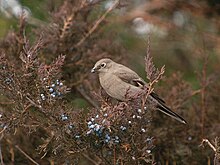Townsend's solitaire
| Townsend's solitaire | |
|---|---|

| |
| Townsend's solitaire by Louis Agassiz Fuertes | |
| Scientific classification | |
| Kingdom: | |
| Phylum: | |
| Class: | |
| Order: | |
| Family: | |
| Genus: | |
| Species: | M. townsendi
|
| Binomial name | |
| Myadestes townsendi (Audubon, 1838)
| |
Townsend's solitaire (Myadestes townsendi) is a medium-sized thrush, the only solitaire native to America north of Mexico.
Range and habitat
This solitaire ranges from southern Alaska, British Columbia and Alberta to northern Zacatecas in Mexico, preferring montane woodlands. During winter, it may move in search of food to lower elevations, including the Great Plains, northern interior Mexico, and even desert oases.[2][3][4]
Description


Townsend's solitaire reaches a length of approximately 8–9.5 inches (20–24 cm) and wingspan of 14.5 in (37 cm); it weighs approximately 1.2 oz (34 g). It has a short, thick, blackish bill; a white eye ring; and gray plumage with a buffy wing stripe and edges of the flight feathers. The tail is long, tapered when shut, and edged with white. Juveniles are mottled gray and white.[2][3]
It perches in a rather upright position, often high on a branch[4] and often staying still for a long time.[3]
Though it has some similarities to the northern mockingbird,[4] particularly as to the tail,[2] its dark underparts, shape, size, and behavior are not similar.
It feeds primarily on berries and insects.[4] The solitaire is amongst the most specialized of all North American birds since its diet in winter consists almost entirely of the fleshy cones of the juniper bush, and the solitary birds form territories around productive juniper patches which they strongly defend [5]
Voice
Its song consists of loud, melodious flute-like rising and falling phrases[4] with "low, husky notes interspersed but no distinct pattern"[2] and "a slightly mechanical quality."[3] The call is a squeaky eeek[4] or "clear, soft whistle heeh".[2]
Nesting
The nest resembles that of other solitaires: a cup of fine plant material on or close to the ground.[3] Townsend's solitaire usually lays three or four eggs that are grayish-white with brown dots or splotches concentrated at the larger end.[4]
Etymology
The name of this bird commemorates the ornithologist John Kirk Townsend.
References
- ^ Template:IUCN
- ^ a b c d e Sibley, David (2000). The Sibley Guide to Birds. Knopf. p. 400. ISBN 0-679-45122-6.
- ^ a b c d e Howell, Steve N. G.; Webb, Sophie (1995). A Guide to the Birds of Mexico and Northern Central America. Oxford University Press. p. 583. ISBN 0-19-854012-4.
- ^ a b c d e f g "Townsend's Solitaire Myadestes townsendi". eNature.com Nature Guides. 2005. Retrieved 2007-08-17.
- ^ Bock, C. 1982. Factors influencing winter distribution and abundance of Townsend's Solitaire. Wilson Bulletin 94: 297-302
- General
- "Myadestes townsendi". Integrated Taxonomic Information System. Retrieved 4 February 2006.
External links
- Townsend's solitaire at USGS
- Townsend's solitaire photo gallery VIREO; (with picture: egg clutch)
- Townsend's solitaire photo, Article Washington State

